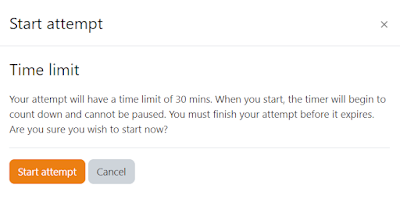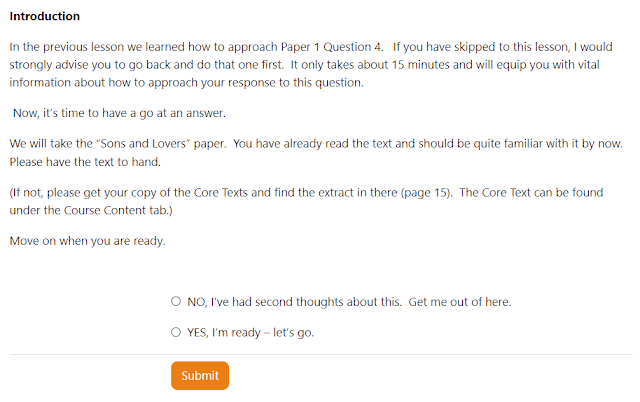Doing a quiz in class is a popular activity among students, particularly when it’s low-stakes (where students are given the chance to try repeatedly, make mistakes and potentially fail and to learn from those mistakes with no academic penalty). That’s what our interactive quizzes are all about.
Our quizzes can be done as many times as learners want. They are all based around the questions they will get in the exams. So, as well as strengthening English skills in general they are designed to increase awareness of the questions and, more importantly even, how to successfully respond to them. We use a
Moodle platform, so if you are a GCSE English teacher, have a look at how you can use it to create an engaging learning area for your learners (without the impermanence of whichever VLE your institution has chosen).
There are a number of ways to access the quizzes but perhaps the best is to go to the right-hand sidebar and to click “quizzes” in the “Activities” section.
This lists all the different activities available on the site and is a really good short-cut to them if you know exactly what you want to do.
They each have a unique URL too which means that you can email the link directly to students.
Once you select “Quizzes”, you will then get a list of the quizzes available to you – including the scores that you got on the ones that you previously attempted.
They are all contained in their correct topic and are clearly named, so you should know what you are letting yourself in for!
Let’s click onto the first quiz about structure (it's not in the image above as it only shows the quizzes up to Paper 1 Question 2).
As you can see, you get a few instructions before you do the quiz. First of all it will tell you what you have done and what you are to do – so you have viewed the quiz, but you need to receive both a grade and a passing grade. It then tells you the day it was set – that’s the day it was made live on the site, so don’t worry about that. Then there is the orange button that you click when you want to attempt the quiz, with a warning below that it is time-constrained – you only get 30 minutes to do this. Finally, there is the passing grade. This is set quite low on this quiz as it is the first one on the subject of structure. The pass grades will get higher in subsequent quizzes – but we don’t want to put you off to begin with!

If you decide to proceed with the quiz, then you click on the orange “Attempt quiz” button. You will then see this message.
This is to make sure that you are ready. If you are, click the orange “Start Attempt” button. Otherwise, just “Cancel” it.
Now you are in the quiz. In this instance, it is a quiz called “The Gladiator”.
In this quiz you have to read a (very) short story first. This reflects the structure question in the exam, where you can respond to any part of a text. So other quizzes will have shorter texts to read, in general!
Once you have read the text you can start answering the questions. The great thing about quizzes created using Moodle are that they can be multiple choice…
Or you may have to do some ordering…
Or you may have to drag and drop the right words into an example student response.
There are other types of question, too. However, these are the three types you are most likely to see in our quizzes.
While you are doing the quiz, if you come across a question that you
can’t answer, you can flag it to come back to it later. If you look at the quiz navigation pane on the right, you will see I have flagged the third question. You can go back to it at any time by clicking on it.
If you finish the quiz before the time is up then you can submit it early. You get a list of the question you have answered, so you can quickly check that you have answered them all.
Then, when you are ready, click the orange "Submit all and finish" button. The software will ask you to confirm this.
You will automatically go into review mode. This will tell you how many you got right (green), how many you got wrong (red) and how many you got partially correct (amber).
You can end the review at any time by clicking “Finish Review” at the bottom of the quiz navigation, but unless you got everything right, my advice is that you look at the questions you got wrong – review them.
If you scroll through the quiz, you will get feedback. Here is an example for a multiple-choice question.
Some questions, like the drag and drop ones, will tell you which ones you got right and wrong. This guidance is there so you can work out why you got some of them wrong. Every time you work something like this out you get a few extra brain cells!
Once you click “Finish Review” then you are taken to a final screen which lists when you did the quiz, how many answers you got right and how many attempts you made.
You can start a new attempt at any time after this point or return to this attempt and review it again - so the quiz is not only good for learning but great for revision, too.
Alternatively, you can go and watch something on the telly.
Now you have read through this, we hope you will agree that quizzes are really useful when it comes to getting ready for GCSE English. The Moodle platform we use enables us to give you a much greater variety of question types than with most other quizzing software on the internet. You can also return to your quizzes whenever you want without having to bookmark the URL. We regularly release new quizzes, too, which means you can keep on improving your GCSE English knowledge and skills as you work towards the final exams.


















































